Construcción y evaluación de una celda de combustible microbiana con materiales de bajo costo
Contenido principal del artículo
Resumen
Las celdas de combustible microbianas son dispositivos que permiten transformar energía química almacenada en compuestos orgánicos en energía eléctrica, utilizando microrganismos depositados sobre un electrodo. Entre las ventajas que posee esta tecnología se destaca la posibilidad de limpiar o tratar matrices acuosas como aguas residuales. A continuación se reporta, como prueba de concepto, la construcción de una celda de combustible microbiana empleando materiales reciclados o de bajo costo. El consorcio de bacterias electrogénicas utilizadas se aisló de sedimentos del embalse Amaluza, en Cuenca, Ecuador. La celda se puso en funcionamiento utilizando aguas residuales domésticas reales, obtenidas del barrio Ubilus de la parroquia Pintag del cantón Quito, Ecuador. La celda de combustible construida generó una densidad de potencia de 40 mW/m2 con un porcentaje de remoción de materia orgánica cercano al 80 %. Siguiendo el concepto de economía circular, se midió la concentración de nitrógeno, fosforo y potasio en la biomasa producida por la celda para su posible aplicación como aditivo ecológico de fertilizantes.
Descargas
Detalles del artículo
- Los autores se comprometen a respetar la información académica de otros autores, y a ceder los derechos de autor a la Revista infoANALÍTICA, para que el artículo pueda ser editado, publicado y distribuido.
- El contenido de los artículos científicos y de las publicaciones que aparecen en la revista es responsabilidad exclusiva de sus autores. La distribución de los artículos publicados en la Revista infoANALÍTICA se realiza bajo una licencia Creative Commons Reconocimiento-CompartirIgual 4.0 Internacional License.
Citas
Metals by flame atomic absorption spectrometry (2018). In Standard Methods For the Examination of Water and Wastewater. American Public Health Association. https://doi.org/doi:10.2105/SMWW.2882.043
-N nitrogen (2018). In Standard Methods For the Examination of Water and Wastewater. American Public Health Association. https://doi.org/doi:10.2105/SMWW.2882.086
-P phosphorus (2018). In Standard Methods For the Examination of Water and Wastewater. American Public Health Association. https://doi.org/doi:10.2105/SMWW.2882.093
chemical oxygen demand (COD) (2018). In Standard Methods For the Examination of Water and Wastewater. American Public Health Association. https://doi.org/doi:10.2105/SMWW.2882.103
Aelterman, P., Rabaey, K., Clauwaert, P., & Verstraete, W. (2006). Microbial fuel cells for wastewater treatment. Water Science and Technology, 54(8), 9–15. https://doi.org/10.2166/wst.2006.702
Bassante, N. (2018). Evaluación del efecto de polímeros conductores en el tratamieno de aguas residuales domésticas utilizando celdas de combustible microbianas. Universidad Central del Ecuador.
Behera, M., & Ghangrekar, M. M. (2011). Electricity generation in low cost microbial fuel cell made up of earthenware of different thickness. Water Science and Technology, 64(12), 2468–2473. https://doi.org/10.2166/wst.2011.822
Buitrón, G., & Cervantes-Astorga, C. (2013). Performance evaluation of a low-cost microbial fuel cell using municipal wastewater. Water, Air, and Soil Pollution, 224(3). https://doi.org/10.1007/s11270-013-1470-z
Choi, S. (2015). Microscale microbial fuel cells: Advances and challenges. Biosensors and Bioelectronics, 69, 8–25. https://doi.org/10.1016/j.bios.2015.02.021
Do, M. H., Ngo, H. H., Guo, W. S., Liu, Y., Chang, S. W., Nguyen, D. D., Nghiem, L. D., & Ni, B. J. (2018). Challenges in the application of microbial fuel cells to wastewater treatment and energy production: A mini review. Science of the Total Environment, 639, 910–920. https://doi.org/10.1016/j.scitotenv.2018.05.136
Geissdoerfer, M., Savaget, P., Bocken, N. M. P., & Hultink, E. J. (2017). The Circular Economy – A new sustainability paradigm? Journal of Cleaner Production, 143, 757–768. https://doi.org/https://doi.org/10.1016/j.jclepro.2016.12.048
Hernandez-Fernandez, F. J., de Los Rios, A. P., Salar-Garcia, M. J., Ortiz-Martinez, V. M., Lozano-Blanco, L. J., Godinez, C., Tomas-Alonso, F., & Quesada-Medina, J. (2015). Recent progress and perspectives in microbial fuel cells for bioenergy generation and wastewater treatment. Fuel Processing Technology, 138, 284–297. https://doi.org/10.1016/j.fuproc.2015.05.022
Li, M., Zhou, M., Tian, X., Tan, C., Cameron, T., Hassett, D. J., & Gu, T. (2018). Microbial fuel cell (MFC) power performance improvement through enhanced microbial electrogenicity Ming. Biotechnology Advances, December 2017, #pagerange#. https://doi.org/10.1016/j.biotechadv.2018.04.010
Logan, B. E. (2007). Microbial Fuel Cells. John Wiley & Sons, Inc. https://doi.org/10.1002/9780470258590
Logan, B. E., Hamelers, B., Rozendal, R., Schröder, U., Keller, J., Freguia, S., Aelterman, P., Verstraete, W., & Rabaey, K. (2006). Microbial fuel cells: Methodology and technology. Environmental Science and Technology, 40(17), 5181–5192. https://doi.org/10.1021/es0605016
Logan, B. E., & Rabaey, K. (2012). Conversion of wastes into bioelectricity and chemicals by using microbial electrochemical technologies. Science, 337(6095), 686–690. https://doi.org/10.1126/science.1217412
Rabaey, K., & Verstraete, W. (2005). Microbial fuel cells: Novel biotechnology for energy generation. Trends in Biotechnology, 23(6), 291–298. https://doi.org/10.1016/j.tibtech.2005.04.008
Rea, H. S. (2017). Evaluación de la biomasa producida por el tratamiento de aguas residuales domésticas usando celdas de combustible microbiano (MFCs) como posible abono agricola. Universidad Central del Ecuador.
Sacco, N. J., Figuerola, E. L. M., Pataccini, G., Bonetto, M. C., Erijman, L., & Cortón, E. (2012). Performance of planar and cylindrical carbon electrodes at sedimentary microbial fuel cells. Bioresource Technology, 126, 328–335. https://doi.org/https://doi.org/10.1016/j.biortech.2012.09.060
Sivasankar, V., Mylsamy, P., & Omine, K. (Eds.). (2018). Microbial Fuel Cell Technology for Bioelectricity. Springer International Publishing. https://doi.org/10.1007/978-3-319-92904-0
Wei, B., Tokash, J. C., Chen, G., Hickner, M. A., & Logan, B. E. (2012). Development and evaluation of carbon and binder loading in low-cost activated carbon cathodes for air-cathode microbial fuel cells. RSC Advances, 2(33), 12751–12758. https://doi.org/10.1039/C2RA21572A
Zhang, F., Cheng, S., Pant, D., Bogaert, G. Van, & Logan, B. E. (2009). Power generation using an activated carbon and metal mesh cathode in a microbial fuel cell. Electrochemistry Communications, 11(11), 2177–2179. https://doi.org/https://doi.org/10.1016/j.elecom.2009.09.024

